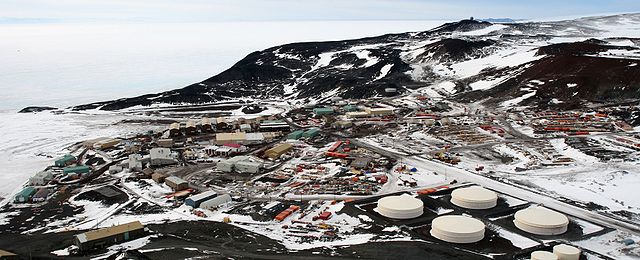The South Pole Traverse, also called the South Pole Overland Traverse, is an approximately 995-mile-long (1,601 km) flagged route over compacted snow and ice in Antarctica that links McMurdo Station on the coast to the Amundsen–Scott South Pole Station, both operated by the National Science Foundation of the United States. It was constructed by levelling snow and filling in crevasses; flags mark its route from McMurdo Station across the Ross Ice Shelf to the Leverett Glacier, where the route ascends to the polar plateau and on to the South Pole.
Satellite photo of McMurdo Station with the South Pole Traverse (central road)
Cargo caravan on the ice highway in early 2006
McMurdo Station is an American Antarctic research station on the southern tip of Ross Island, which is in the New Zealand–claimed Ross Dependency on the shore of McMurdo Sound in Antarctica. It is operated by the United States through the United States Antarctic Program (USAP), a branch of the National Science Foundation. The station is the largest community in Antarctica, capable of supporting up to 1,500 residents, and serves as one of three year-round United States Antarctic science facilities. All personnel and cargo going to or coming from Amundsen–Scott South Pole Station first pass through McMurdo. McMurdo Station continues to operate as the hub for American activities on the Antarctic continent. By road, McMurdo is 3 kilometres (1.9 mi) from New Zealand's smaller Scott Base.
McMurdo Station from Observation Hill
Nuclear reactor commemorative plaque
The supply ship MV American Tern during cargo operations at McMurdo Station during Operation Deep Freeze 2007. The square building in the foreground is Discovery Hut.
McMurdo Station from above.





